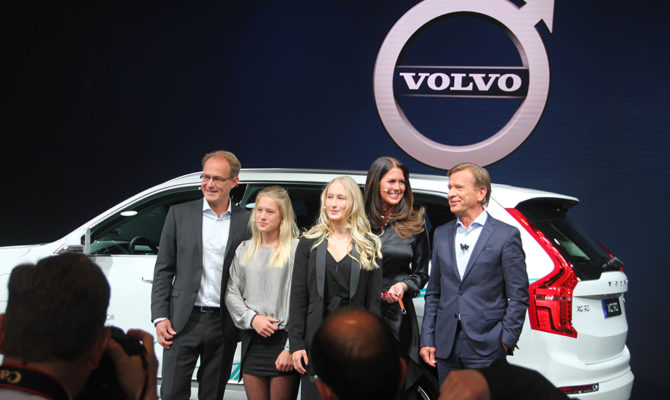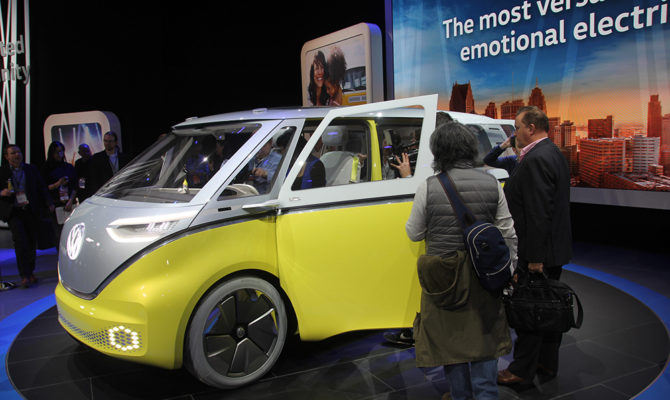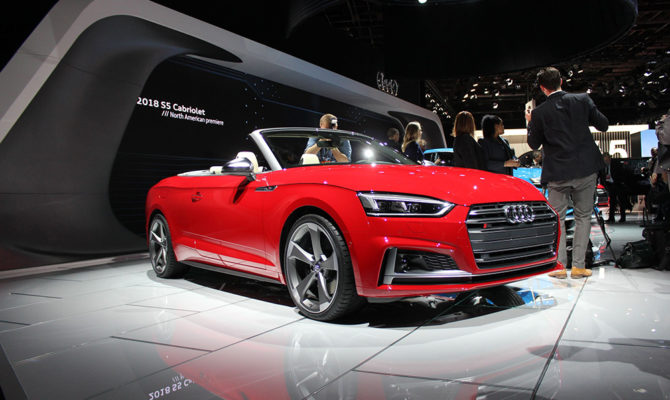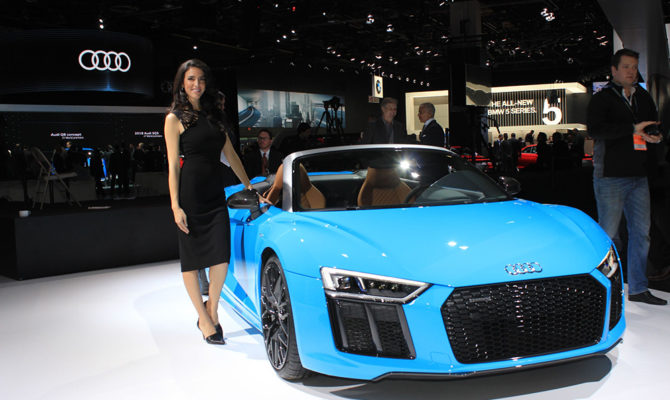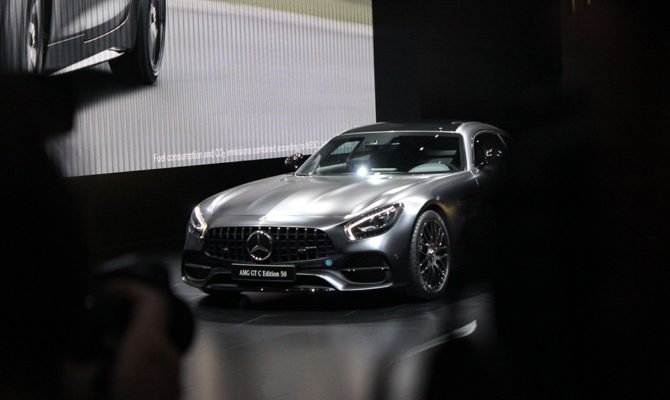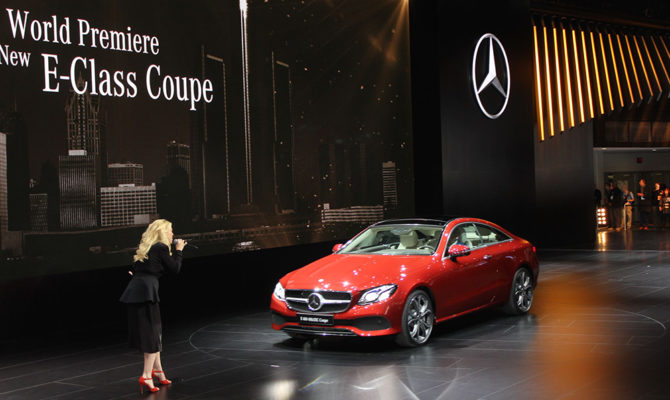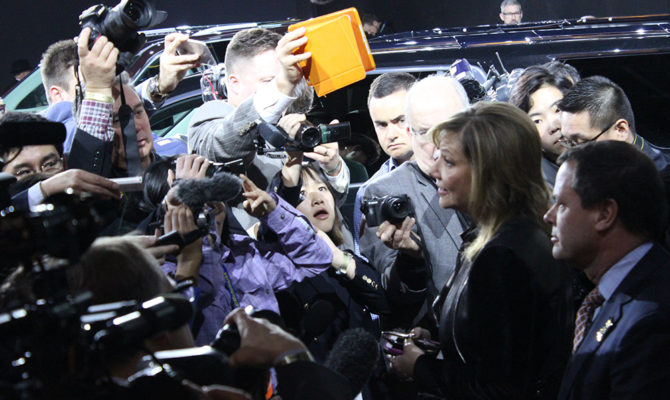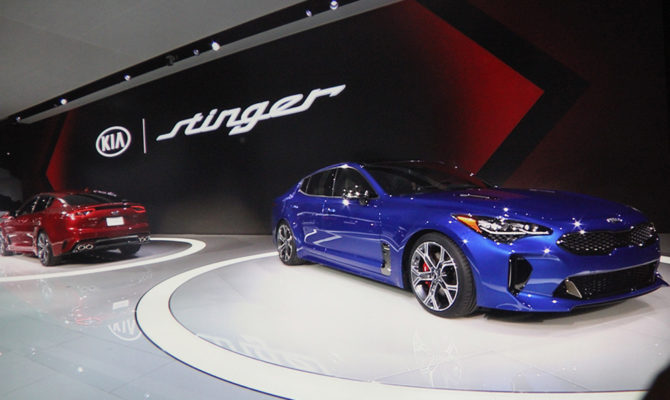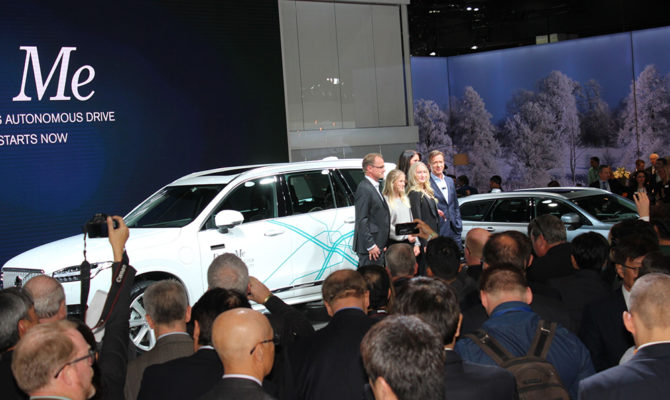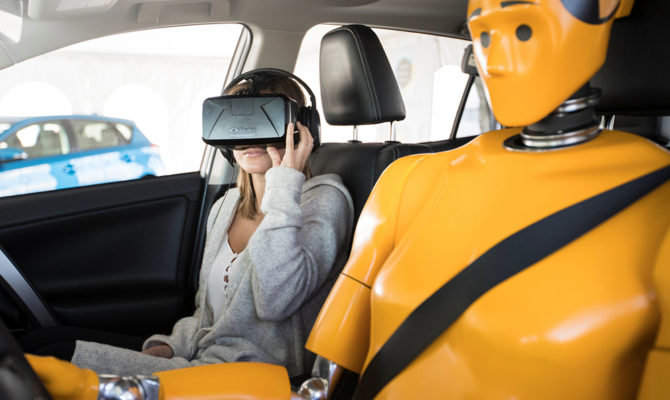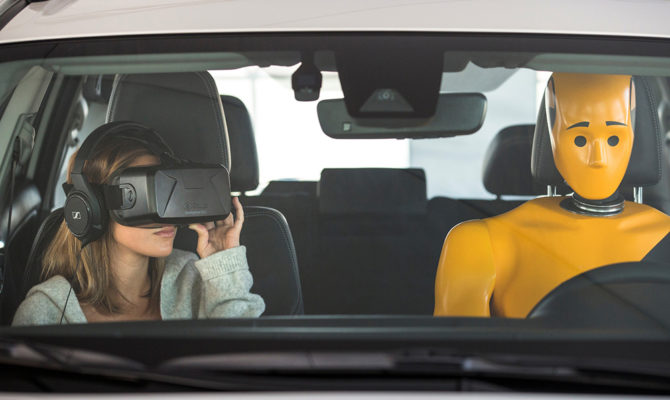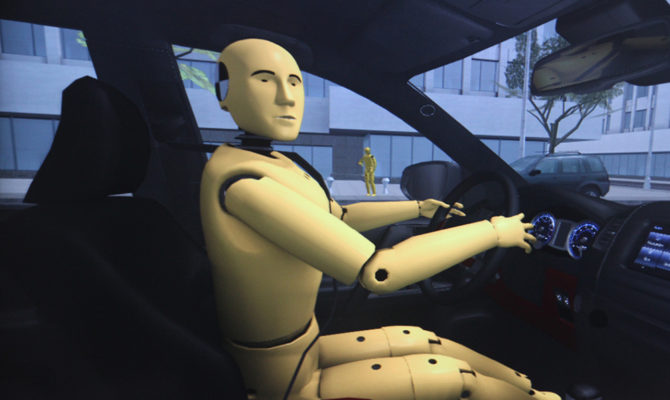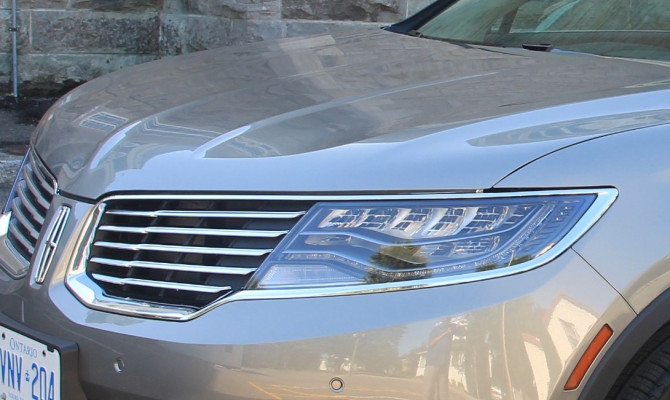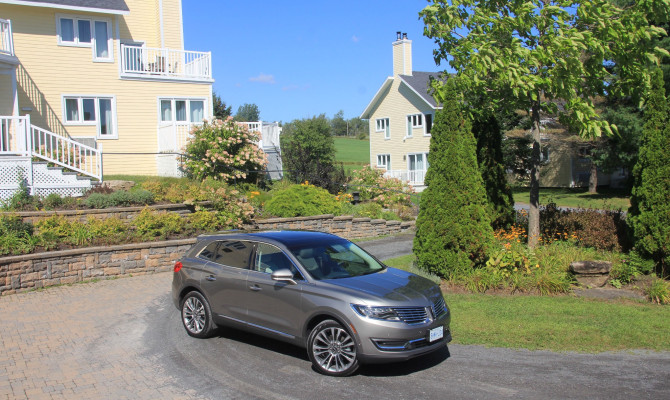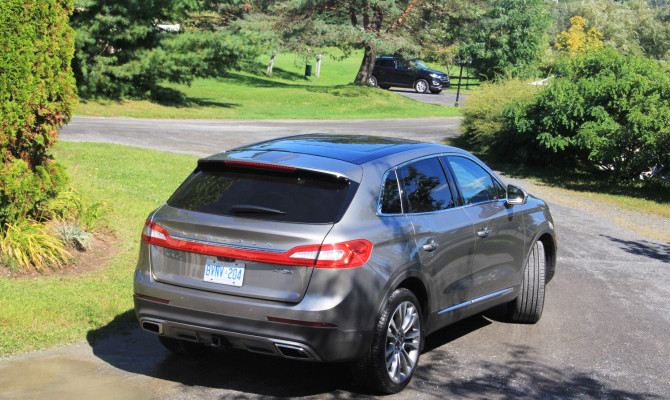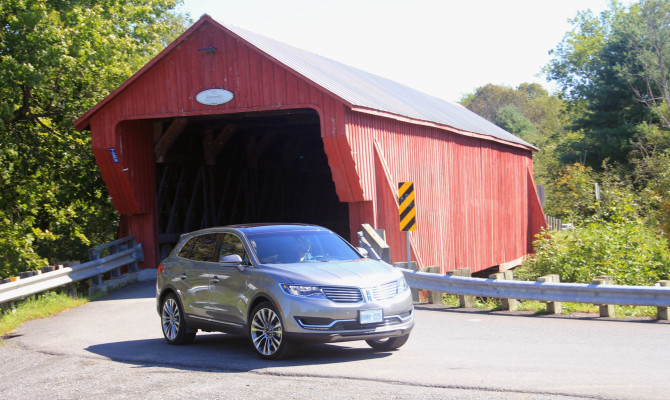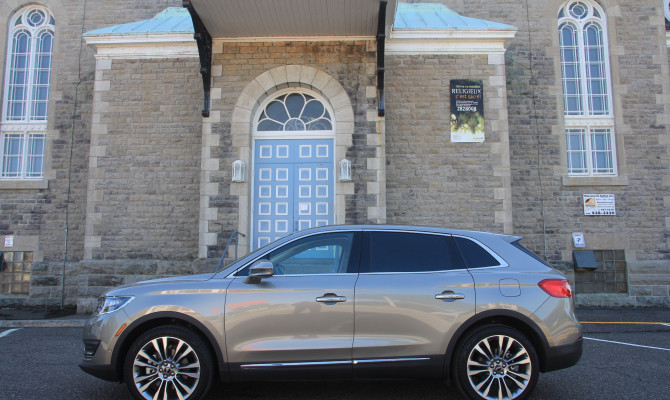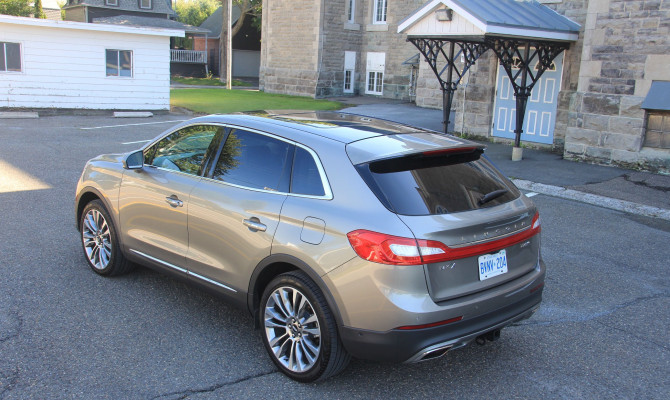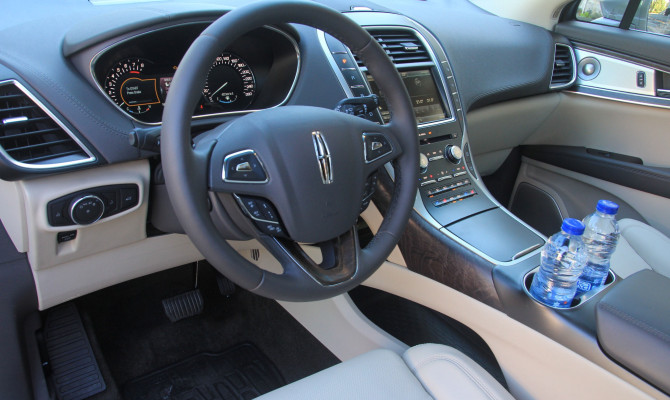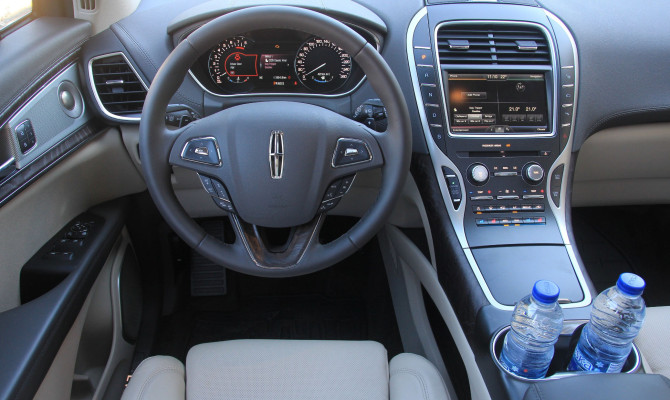“The Canadian International Auto Show media preview featured 41 “New to Canada” vehicle premieres and for the first time ever a “World Premiere”, which was video cast globally, of the 2018 Hyundai Accent.”
PULL QUOTE: “There was a parade of new sport/crossover utes from virtually all manufacturers, all scrambling to get a share of this hot market segment.”
Detroit, MI – It’s been a while since I last attended the annual North American International Auto Show media preview so the invite to the 2017 edition was a treat.
The crowded media feeding frenzies were just the same as ever but the new vehicle intro events, however, tend to be tamer affairs these days. The emphasis is largely on corporate business not show business, which, of course, is sensible … yet, I do miss that old razzle dazzle!
Not here in person, but the Donald Trump-effect was evident, following the president-elect’s unpleasant utterings about manufacturers who shift production outside of the USA. Almost every auto industry spokesperson talked about American vehicle production numbers, American production content, American employment numbers or planned future growth in America, etc. Oddly enough, Chrysler (aka FCA) did not host an auto show press conference this year, in its home city!
The Ford media presentation was another low-key affair, with top executives mainly talking about future mobility, sustainability and autonomous driving. An updated F150 (all-new 3 years ago) was paraded but the big news for Ford fans is that Ranger, a midsize pickup truck, is back in 2019 and an all-new Bronco will follow in 2020. Both will be produced in a Ford assembly plant in Michigan, USA.
My favourite auto industry speaker was Carlos Ghosn, Chairman and CEO, Nissan Motor Co. Ltd.. During his articulate and insightful keynote address he clarified the difference between an autonomous vehicle and a driverless vehicle. He expects there will be various levels of autonomy offered by auto makers, including Nissan in 2021. A driver will be able to choose when he/she wants it to operate this vehicle in an autonomous mode. The Ghosn definition of a driverless vehicle, on the other hand, is one that has no steering wheel or driver controls. Basically, it’s a robotic transportation appliance on wheels.
Volvo introduced us to the Hains family from Gothenburg. They are the first of 100 families who agreed to take an autonomous Volvo XC90 SUV and be part of Volvo’s long-term Drive Me research program. It will be the world’s largest autonomous driving test on real roads and with real people, according to Volvo. Volvo is also working with Uber on an autonomous ride-hailing program.
Volkswagen really set the room abuzz was the I.D. Buzz. Another microbus concept from VW and this one is autonomous and full-electric.
Bucking the driver-less trend of this year’s show, Kia introduced Stinger, a stylish driver-focused rear-drive (or all-wheel-drive) sports sedan. Its 3.3-litre V6 engine can produce 365 horsepower and get Stinger to 100 km/hour in less than 6 seconds.
The Four Rings rang with the world premiere of the company’s latest utility vehicle addition: the 2018 Audi SQ5.
Boasting new suspension and a powerful update to the power train – a 3.0L V6 that claims to blast the compact crossover from zero to 100 in 5.1 seconds with its 354 horses (and 369 lb.-ft. of torque) – marshalled by an eight-speed automatic transmission.
Audi also showed the Q8 Concept vehicle, billed as the “first full-size SUV in coupe design”, is the basis of what will become, they say, a production vehicle that will be launched for real in 2018 as a powerful (and of course luxurious) hybrid that are already looking forward to here at Driveway.
Mercedes Benz kicked off with a musical quartet that culminated in the German manufacturer’s personable chairman Dieter Zetsche taking the stage. The 2018 GLA compact SUV gets a new face for the new year, and redesigned bumpers. The E-class Coupe made its world debut, adding to an already comprehensive array of recent new models from Benz.
High-tech safety features that, not too long ago, were pricey options and only available on prestigious models, are now standard on two of Toyota’s most popular models.
Every 2017 Toyota Corolla and 2017 Toyota RAV4 comes with a Toyota Safety Sense (TSS) package and almost every new Toyota sold by the end of 2017 will come with this innovative safety package.
“Canadians will buy more than 150,000 vehicles equipped with Toyota Safety Sense over the next 12 months,” according to Stephen Beatty, Vice-President Toyota Canada Inc. at a driving demonstration event in Maple Ridge.
A Pre-Collision System, Automatic High Beam and Lane Departure Alert are all included in the base TSS bundle and there’s a TSS-P package that also adds Dynamic Radar Cruise Control and a pedestrian detection function.
Beatty did, however, emphasise that these clever active safety systems are designed to “enhance, not replace, driver control”. Due to cost savings gained through innovation and high volume production, he also estimated that TSS only added about $300 to the price of these 2017 models.
The Pre-Collision System (PCS) uses a camera and laser beam to detect a vehicle ahead. It first prompts the driver to take evasive action if a collision is looming, with an audio and visual alert. It can provide additional braking force using a Brake Assist feature and it will automatically apply the brakes (full force), if no action is taken by the driver. Obviously, road conditions and other factors can influence the outcome, however, a live demonstration in a RAV4 certainly proved how effective PCS can be.
The operational range (approximately 10 – 80 km/hour) of PCS covers speeds at which at least 80 per cent of rear-end collisions occur, according to Toyota. TSS-P enhances the speed range of PCS and adds a Pedestrian Detection feature by using a millimetre-wave radar upgrade in combination with a camera.
Lane Departure Alert (LDA) uses a camera to detect lane markings in front of the vehicle and the vehicle’s position on the road. The driver gets an audio and visual alert if the system determines that the vehicle is drifting from its intended lane. TSS-P enhances LDA by adding a Steering Assist function, which guides Corolla back into its lane, and adds Dynamic Radar Cruise Control.
Automatic High Beam (AHB) uses the windshield mounted camera (behind the rear-view mirror) to help detect headlights of oncoming vehicles and tail lights of preceding vehicles. It then automatically switches between high and low beams as appropriate to provide the most light possible and enhance forward visibility.
Could this be the dawn of a whole new generation of intelligent automobiles with active safety? Leading to a day when all vehicle-to-vehicle collisions are eliminated. That’s probably too far ahead to predict, but it’s certainly possible. Toyota did use an interesting, and futuristic, virtual reality (VR) demonstration to highlight the advantages of TSS.
It was my first experience of the very cool visual world of three-dimensional VR, which is created by using a headset connected to interactive software and hardware. You’re able to freely “look around” in an artificial world, which your body doesn’t inhabit … yeah, it’s a little weird. Apparently it will be part of Toyota’s auto show traveling display. If you get an opportunity, do check it out.
In the real world, we also got an opportunity to drive 2017 editions of the Corolla sedan and the new Corolla iM, with the TSS system. Yes, the iM is effectively a re-badged Scion model. That said, it’s also a cleverly designed hatchback with double-wishbone rear suspension, more standard equipment, extra support seating, plus a sportier feel and attitude.
Ford continues its quest to bring us ground breaking new active safety technologies in affordable automobiles (more…)
The early morning gut tester of a drive certainly helped showcase the impressively agile and predicable handling abilities of the XT5.
The self-driving car is rapidly moving from concept to reality and fully autonomous cars will arrive sooner than you think.
(more…)
“Like most vehicles in this class, numerous helpful driver safety aids are available for the MKX and include adaptive cruise control, lane-keeping system, blind spot information system and cross-traffic alert.”
Montreal, Quebec.
The Lincoln brand has been on a sales revival roll of late, especially since we discovered that movie star Matthew McConaughey is, and long before anyone paid him to drive them, captivated by Lincoln vehicles.
Well, he’s got another one to drool over now, the all-new Lincoln MKX.
The midsize premium utility segment, where the new Lincoln MKX will circulate, represents a whopping 25 per cent of all luxury market sales in Canada. That’s a far bigger (percentage-wise) chunk of the premium auto pie than this segment draws in the US. Additionally, the MKX is made in Canada and rides on a new CD4 platform that it shares with the Ford Edge.
The second generation (first generation debuted as a 2007 model) redesign, however, moves this MKX even further away from its Ford family ties. The new body is lower and wider with curvaceous sculptured lines above the front and rear wheel openings. Up front, a new rendition of the Lincoln split-wing grille can come with adaptable LED headlights with blade-like projectors that aligned with the new horizontal grille bars.
Not only do the new LED headlights look sharp, they also provide better light. At speeds below 56 km/hour, LED reflector elements provide a wider and lower beam pattern. At higher speeds the light is re-focused to project further down the road.
The Lincoln MKX drive experience is primarily about comfort, quietness and abundant power, which the new optional 2.7 litre V6 EcoBoost engine certainly provides. It can deliver up to 330 hp, yet what’s most impressive about this engine is its silky, smooth V8-like performance with beefy torque output (up to 370 lb-ft), especially at low engine speeds. The carry-over base engine is a 3.7-litre, 300-hp V6.
That said, MKX buyers will pay a hefty premium for the 2.7-litre twin-turbo engine. Pricing for a 3.7 MKX starts at $45,890, but it jumps to $53,940 for the 2.7 EcoBoost version. Then again, that’s still a bargain compared to Euro competitors like a BMW X5 ($65,500 to $85,200) or a Mercedes-Benz GLE ($63,200 to $81,100).
Our test-drive tour through the Eastern Townships of Quebec confirmed that the MKX is a worthy wearer of the Lincoln badge. This picturesque area of La Belle Province is dotted with quaint little villages huddled around magnificent church buildings. Many of the roads, however, still bear the scars of those bitterly cold winters that Quebecers are accustomed to enduring.
The new integral link rear suspension, as well as the body structure and chassis upgrades, passed the rough-road challenge with aplomb. The MKX comes standard with Lincoln Drive Control, a suite of ride-enhancing technologies and it offers three driving modes (Normal, Sport and Comfort). The Lincoln “Intelligent” all-wheel drive system is also standard, as is a new adaptive electric power-assisted steering system that can change both steering feel and quickness, dependent on a number of operating factors.
While I prefer a shift lever of some type, the push-button transmission selector on the dash does give the MKX interior a sleek, uncluttered appearance. The selector connects to six-speed automatic transmission (both engines) and shifts can also be made via paddles on the steering wheel. City/highway fuel economy is rated at 14.7/10.3 L/100km (3.7L V6) and 14.1/9.7 L/100 km (2.7LV6).
Clever, under-console storage has also been created and super comfy 22-way adjustable front seats are a new option. These seats come with an active motion massage feature for the upper legs and lower back via six adjustable air bladders. They also come with four-way power head restraints and power thigh extenders.
If parking is not your favourite pastime Lincoln MKX has a couple of new technology solutions. An enhanced park assist system, offers 360-degree camera coverage to provide a birds-eye view of the vehicle (and up to almost two metres all around it), making any low-speed parking situation easier. An even more advanced “auto-pilot” parking system, with 12 ultrasonic sensors, can now guide MKX into a perpendicular parking stall, in addition to parallel parking assist and park out assist.
Like most vehicles in this class, numerous helpful driver safety aids are available for the MKX and include adaptive cruise control, lane-keeping system, blind spot information system and cross-traffic alert. A new pre-collision assist system helps avoid or lessen the severity of frontal impacts with another vehicle, or a pedestrian.
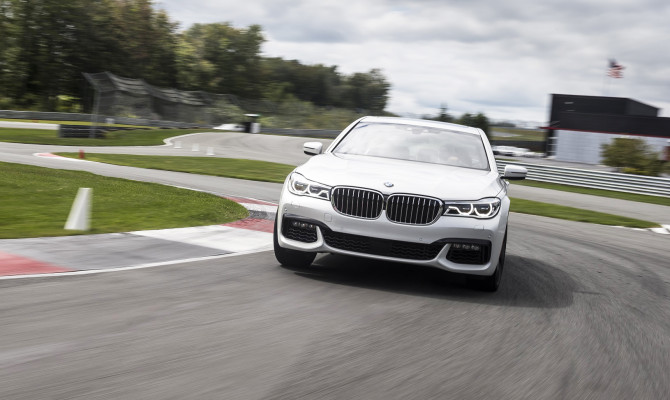
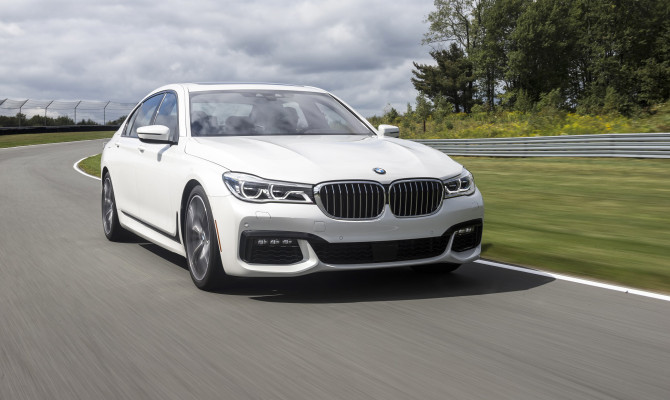
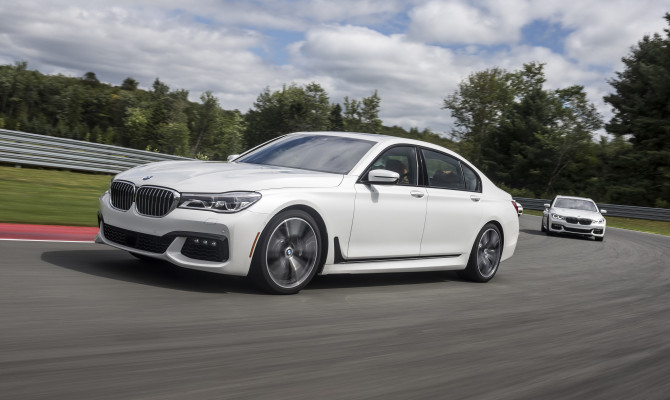
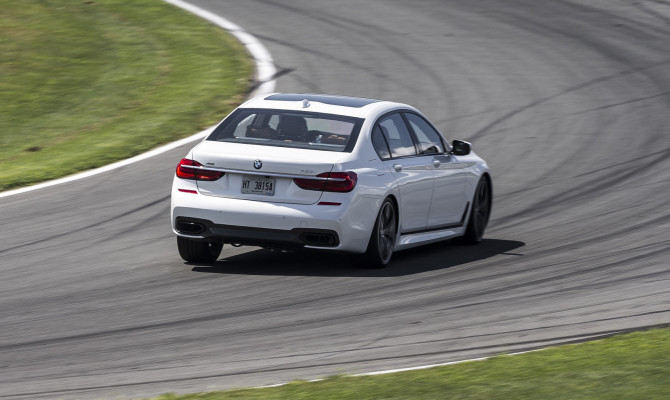
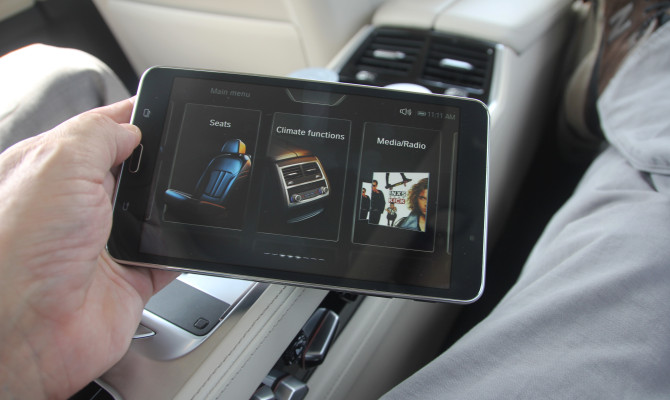
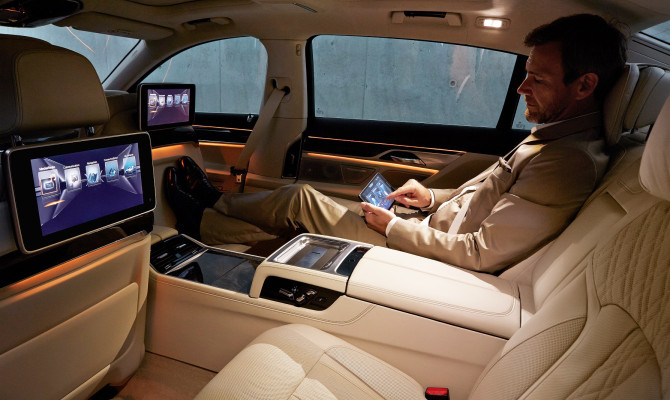
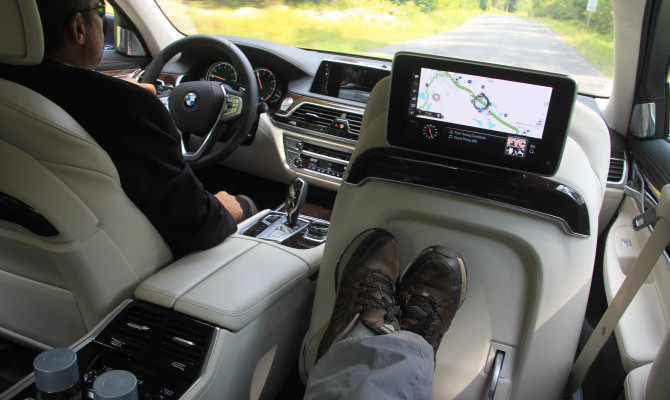

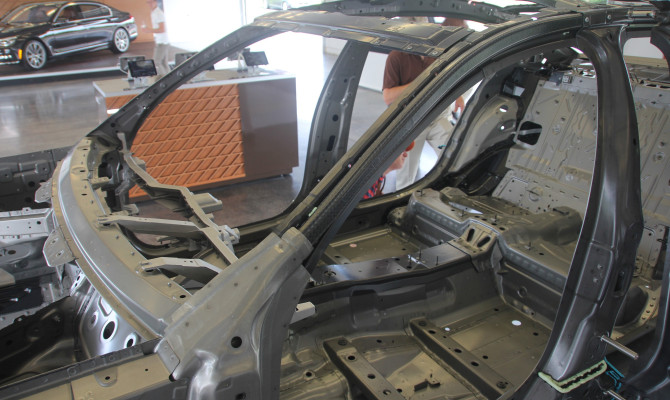
New York.
The all-new 2016 BMW 7 Series is a sixth generation edition of the brand’s big, flagship sedan.
The new styling is another evolutionary step and still instantly recognizable as a BMW. Dimensionally this car is the same as the outgoing model, yet it has a radically new and innovative sub-structure.
And the latter, coupled with remarkable onboard technology, is what caught my attention. Today, much is unique to the 7 series but, figuratively speaking, tomorrow it will spread through the range and the day after it will doubtless be coming to a car near you!
The new 7 Series, offers a showcase of the very latest technologies that BMW has to offer, combined with more advanced forms of technologies already available. Sadly, a novel driverless “self-parking” technology (controlled by the key fob and available in Europe) has not (yet) received Canadian regulatory approval. A similar (delayed approval) story also applies to a new adaptive LED headlight option.
Another fascinating new (multi-media) feature is Gesture Control, which lets an operator do things like raise audio volume by twirling your finger, take a phone call with a finger point or wave it away with a wrist flick. An operator can also add customized gestures to trigger a function… a couple come to mind!
Pandering to the non-driving owners is an interesting optional interior first for BMW, a feature called “Executive Lounge”. A feet-up recliner in the right rear seat has a body massage feature and a multi-media experience controlled by a removable touch-screen tablet, which is mounted in a clever docking feature. Got to admit, it was rear seat test drive to savour – and yes, I do love this job!
BMW is pioneering a different way to improve body rigidity and reduce weight, explained Dr. Wolfgang Hundt, the Project Manager for Driving Dynamics & Driving Assistance. It uses carbon-fibre (reinforced plastic) in key (core) locations of the structure of the new 7 Series. An indicator of how strongly committed BMW is to the use of this ultra-light yet super-strong material is the expansion work (to triple production output) already in progress at its relatively new Moses Lake (Washington State) carbon-fibre manufacturing plant.
I was most impressed by the balance and poise of the 750i xDrive (with an M-Sport package) on the Monticello Motor Club, in up-state New York. In Sport mode the new 7 is so wonderfully light on its feet that you can very easily forget you’re behind the wheel of a big sedan. This mode drops the standard air suspension an additional 10mm and it seems to firm-up and tighten everything. The difference between Sport and Comfort modes was quite dramatic and there’s a new one “Adaptive”. It matches the vehicle set-up to the driver’s current driving style and a profile of the route ahead, by talking to the navigation system.
A redesigned optional Integral Active Steering system can now be offered in conjunction with the xDrive all-wheel drive system. It can turn the rear wheels in the same or an opposing direction as the front wheels to increase manoeuvrability in urban traffic and agility at highway speeds.
The extremely rigid body structure is a ground-breaking marriage of steel, aluminum and carbon-fibre (core) members. The end result is a 7 Series with a much lower centre of gravity and close to perfect front/rear weight distribution.
The 750i xDrive and 750Li xDrive editions will soon be arriving in Canadian BMW dealer showrooms. A BMW 750i xDrive model will have a starting MSRP of $113,900, and a long-wheelbase 750iL xDrive at $117,900. Pricing, which should be lower, for the 740 editions will be announced closer to market launch next year.
A redesigned 4.4 litre V 8 engine with TwinPower Turbo technology can produce 445 hp and rocket a 750i to 100 km/h in 4.5 seconds (according to BMW). It’s teamed with an eight-speed automatic and a new version of BMW’s intelligent all-wheel-drive system in the 750i xDrive.
BMW’s venerable 3.0-litre inline 6-cylinder engine, which now also features TwinPower Turbo technology, will power 740i xDrive and 740Li xDrive editions. A plug-in hybrid 740e xDrive will also join the model lineup in 2016. Its 2.0-litre gas engine is paired with electric drive unit that’s integrated into the eight-speed Steptronic transmission and it comes with a lithium-ion battery pack.
“A champion of the un-paved path, Jeep Wrangler Unlimited allows owners to pack more gear and share their outdoor adventure…”
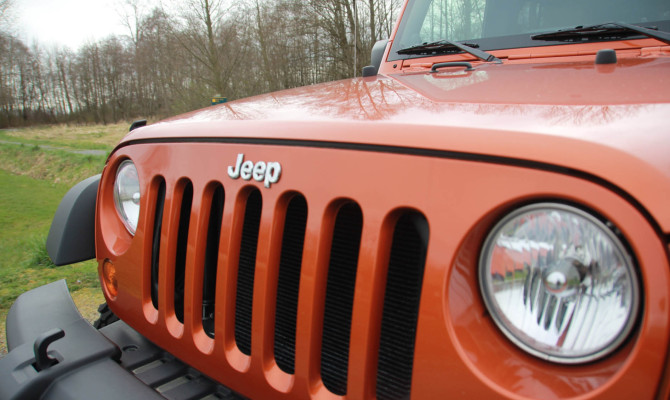
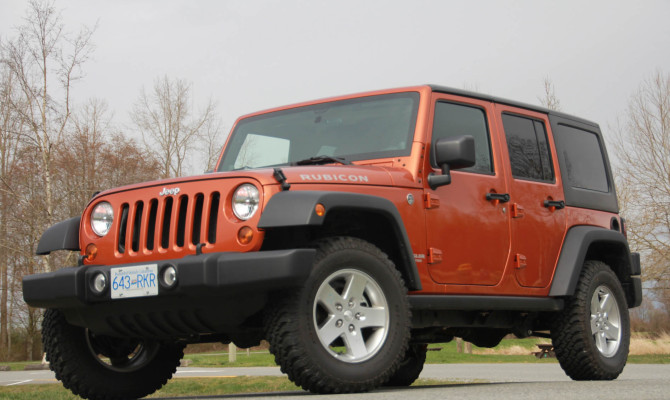
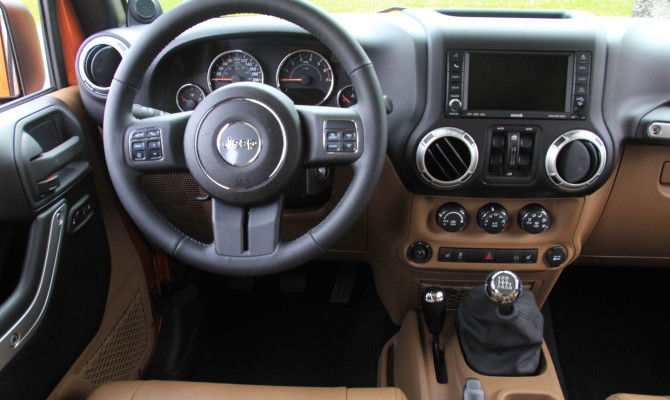
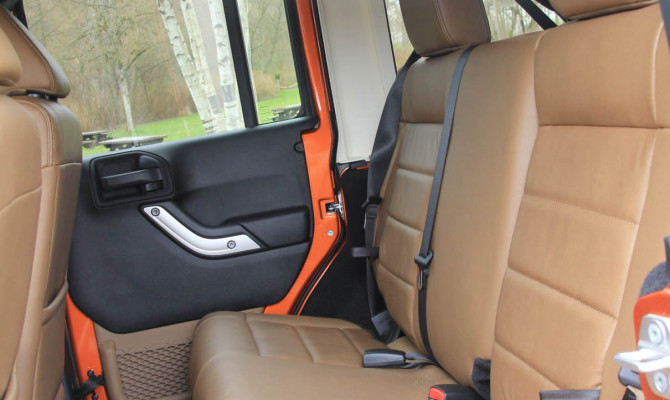
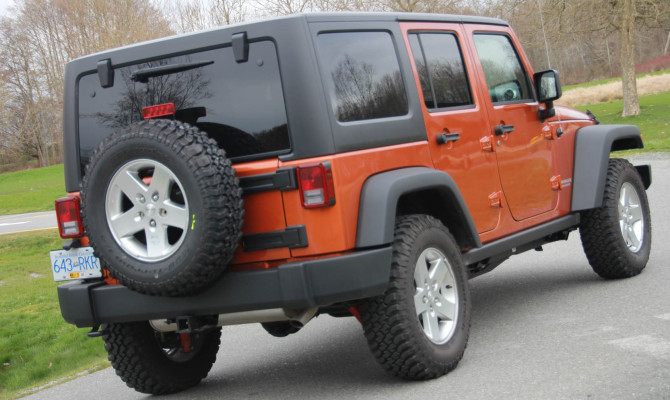
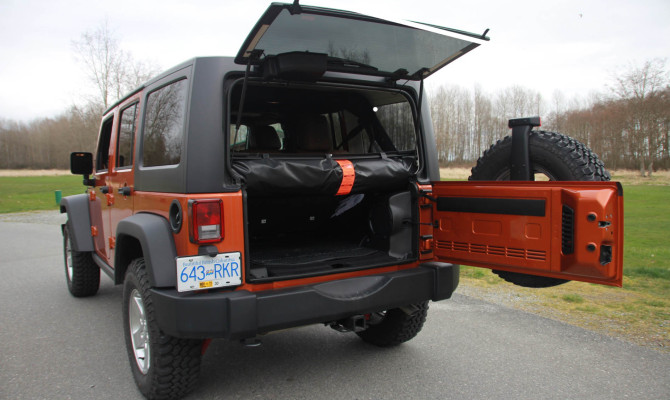
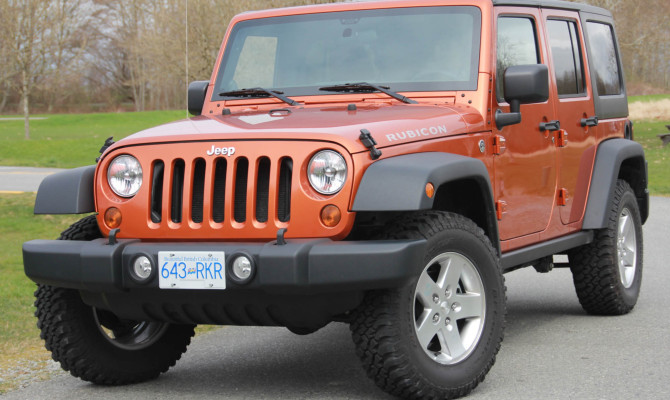
In 2007, Jeep introduced a new longer wheelbase, 4-door version of its iconic “Wrangler” utility vehicle that it called “Wrangler Unlimited”.
It must have been a “Why didn’t we think of this before?” moment for the Jeep organization, as Wrangler Unlimited quickly widened the market appeal of this outstanding off-road vehicle.
See: Jeep’s Wrangler Unlimited (Jeep.ca)
Yes, a longer wheelbase sacrifices a degree of agility, but adds much needed interior space and utility. The stretched body not only allows Wrangler Unlimited to tote more people and/or stuff around, the rear seat is mounted ahead of the rear axle, which gives rear passengers a less bumpy ride. When the seats are folded, they present a completely flat extended cargo floor and 2,353-litres of storage space.
Fast-forward to the 2011 model year and Wrangler Unlimited may still look the same on the outside but it came with an all-new interior. Heated seats, climate control, new audio inputs, Bluetooth connectivity, power-heated side mirrors and a 115-volt electrical outlet, make roughing it outdoors just a tad more comfortable.
Wrangler Unlimited is the only four-door convertible currently on the market and its standard Sunrider soft top has a clever sunroof feature, in addition to a full top-down position. Classic Jeep features include its round headlights, a flat fold-down windshield, exposed door hinges and doors that are easy to remove and available in both full or half frame.
An optional Jeep Freedom Top is a three-piece modular hardtop, which fits over a retracted soft top. In addition to providing a higher level of security, it has three removable panels. There are two Targa-like removable roof panels up front and a larger panel over the rear seats.
Wrangler Unlimited originally came with a torque-rich 3.8-litre V6 coupled either to a six-speed manual transmission or a four-speed automatic. It’s not a light vehicle and tips the scales at a robust 1896 kg (4180 lb), so gas consumption is also heavy.
Expect gas consumption at 15.6/11.8 L/100 km (city/highway – new five-cycle rating) with the automatic transmission. So, to provide its wilderness-wandering customers the extended driving range they expect, Jeep fits an Unlimited with an extra large (85-litre) gas tank.
The base Sport and Sahara trim levels came with a second-generation Command-Trac part-time four-wheel-drive, with a two-speed transfer case and a 2.72:1 low-range gear ratio. A Trac-Lok limited-slip rear differential was optional.
Aimed at serious out-door enthusiasts, the Rubicon edition is probably more Jeep than most buyers need. This off-road-ready machine comes with beefier suspension and steering components, protective skid plates, a roll cage and higher ground clearance. It also has an Off-Road Rock-Trac two-speed transfer case, a 4.0:1 low-range gear ratio, electric front- and rear-axle lockers and an electronic sway bar disconnect.
The 2012 Wrangler Unlimited got a new 3.6 litre V6 engine and a 5-speed automatic transmission. Power output and fuel economy, however, are both roughly the same as the 3.8 litre V6 / four-speed automatic combo they replaced. No significant changes were made to Wrangler Unlimited for its 2013 or 2014 model years.
A champion of the un-paved path, Jeep Wrangler Unlimited allows owners to pack more gear and share their outdoor adventure.
Price Check: 2011 – 2014 Jeep Wrangler Unlimited (April 2015)
Year Edition Expect to Pay Today
2011 Sahara $24,000 to $28,000
2012 Sahara $27,000 to $32,000
2013 Sahara $30,000 to $35,000
2014 Sahara $33,000 to $38,000
Prices vary depending on a used vehicle’s condition, mileage, usage and history. A complete mechanical check should always be performed by a reliable auto technician prior to purchase.
Safety Recalls: 2011 to 2014 Jeep Wrangler:
2011 – 2013: An electrical connector within the door may corrode and potentially result in an electrical short, on vehicles equipped with power heated mirrors. Dealers will modify electrical wiring and install a water shield.
2012 /2013: The power steering return line may wear against the automatic transmission oil cooler line, causing a transmission fluid leak. Dealers will either add a protective sleeve or replace the transmission line.
2011: A missing or incorrectly installed steering column pivot rivet may not perform as intended in a crash and increase the risk of personal injury. Dealers will inspect for steering column rivet presence and alignment, and repair as required.
2010 / 2011: Fastener torque for various front and rear axle attachments may degrade over time, due to variability in the axle painting process. This could result in noise or cause a degradation in the vehicle’s steering and handling characteristics. Dealers will re-torque nineteen fasteners to specifications.
Recent Comments
- { Enjoyed your Forest of Bowland in the BMW X5M, particularly the photo of the BMW in front of the main part of Stonyhurst College where... }
- { Bantam designed the Jeep, not Willy's or Ford. The American military gave the original Bantam prototype to Willys and Ford to copy. There is plenty... }
- { All Escalades come with a 6.2-lilter V8 engine that produces 420 horsepower. A six-speed automatic is the only transmission offered and drives the rear wheels.... }
- { Alexandra is an excellent journalist. }
Popular Posts
- Journey to a ‘Sparkling’ Luxury Okanagan Resort “Four lucky readers will put a Dodge Journey’s weekend-...
- The Need For Speed: Hike Those Highway Limits More than half of those polled believe the province sho...
- Drives-U-Crazy… Erratic drivers. An early morning drive from Kelowna to Vancouver is nor...
- Readers Respond: The Pros and Cons of Increasing B.C. Speed Limits Increasing the speed limits will only increase risk to...
- Honda CR-V Review: The Compact Crossover To Get Things Done The CRV is a very stylish and aerodynamic crossover veh...


